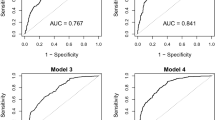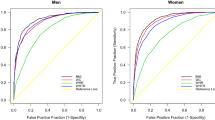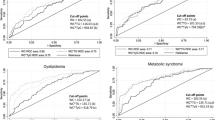Abstract
Objective:
To compare the sensitivities of BMI, waist circumference and waist hip ratio (WHR) in identifying subjects who should be screened for diabetes and/or for obesity-associated dyslipidaemia.
Design:
Cross-sectional study.
Setting:
Central-western France.
Participants:
More than 3000 men and women, aged 40–64 years, from the French study: data from an epidemiological study on the insulin resistance syndrome (D.E.S.I.R.).
Main outcome measures:
Sensitivity and specificity for screened diabetes (fasting plasma glucose⩾7.0 mmol/l) and screened dyslipidaemia (triglycerides⩾2.3 mmol/l and/or HDL-cholesterol <0.9/1.1 mmol/l (men/women)) according to BMI, waist circumference and WHR.
Results:
Sensitivities increased as more corpulent subjects were screened, but they increased slowly after screening the top 30%: body mass index (BMI)⩾27/26 kg/m2 (men/women) or waist ⩾96/83 cm or WHR⩾0.96/0.83. These values were chosen as thresholds. In men, BMI had a nonsignificantly higher sensitivity than waist or WHR for both diabetes and dyslipidaemia (77 vs 74 and 66% P<0.3, 0.09; 56 vs 54 and 49% P<0.5, 0.16). For women, waist had a slightly higher sensitivity than BMI or WHR (82 vs 77 and 77% P<0.8, 0.7) for diabetes; for dyslipidaemia, waist and WHR had similar sensitivities, higher than for BMI (65 and 67 vs 54% P<0.16, 0.13).
Conclusions:
We propose that for screening in a French population 40–64 years of age, the more obese 30% of the population, identified either by BMI, waist or WHR be screened for diabetes and obesity-associated dyslipidaemia.
This is a preview of subscription content, access via your institution
Access options
Subscribe to this journal
Receive 12 print issues and online access
$259.00 per year
only $21.58 per issue
Buy this article
- Purchase on Springer Link
- Instant access to full article PDF
Prices may be subject to local taxes which are calculated during checkout


Similar content being viewed by others
References
Adriaanse MC, Snoek FJ, Dekker JM, van der Ploeg HM, Heine RJ (2002). Screening for Type 2 diabetes: an exploration of subjects' perceptions regarding diagnosis and procedure. Diabet Med 19, 406–411.
American Diabetes Association (2000). Screening for Type 2 diabetes. Diabetes Care 23 (suppl 1), S20–S23.
American Diabetes Association (2004). Screening for Type 2 Diabetes. Diabetes Care 27 (suppl 1), S11–S14.
Baan CA, Ruige JB, Stolk RP, Witteman JCM, Dekker J, Heine RJ et al. (1999). Performance of a predictive model to identify undiagnosed diabetes in a health care setting. Diabetes Care 22, 213–219.
Berber A, Gomez-Santos R, Fanghanel G, Sanchez-Reyes L (2001). Anthropometric indexes in the prediction of type 2 diabetes mellitus, hypertension and dyslipidaemia in a Mexican population. IntJ Obes Relat Metab Disord 25, 1794–1799.
Bertrais S, Balkau B, Vol S, Forhan A, Calvet C, Marre M, et al., the D.E.S.I.R. Study Group (1999). Relationships between abdominal body fat distribution and cardiovascular risk factors: an explanation for women's healthier cardiovascular risk profile. Int J Obes Relat Metab Disord 23, 1085–1090.
Bjorntorp P (1988). Abdominal obesity and the development of noninsulin-dependent diabetes mellitus. Diabetes Metab Rev 4, 615–622.
Després JP, Lemieux I, Prud'homme D (2001). Treatment of obesity: need to focus on high risk abdominally obese patients. BMJ 322, 716–720.
Edelman D, Olsen MK, Dudley TK, Harris AC, Oddone EZ (2002). Impact of diabetes screening on quality of life. Diabetes Care 25, 1022–1026.
Efron B, Tibshirani R (1993). An introduction to the bootstrap. Chapman & Hall: London.
Expert Panel on Detection, Evaluation and Treatment of High Blood Cholesterol in Adults (2001). Executive Summary of The Third Report of The National Cholesterol Education Program (NCEP) Expert Panel on Detection, Evaluation, and Treatment of High Blood Cholesterol in Adults (Adult Treatment Panel III). JAMA 285, 2486–2497.
Glumer C, Carstensen B, Sandbaek A, Lauritzen T, Jorgensen T, Borch-Johnsen K (2004). A Danish diabetes risk score for targeted screening: the Inter99 study. Diabetes Care 27, 727–733.
Griffin SJ, Little PS, Hales CN, Kinmonth AL, Wareham NJ (2000). Diabetes risk score: towards earlier detection of type 2 diabetes in general practice. Diabetes Metab Res Rev 16, 164–171.
Han TS, van Leer EM, Seidell JC, Lean ME (1995). Waist circumference action levels in the identification of cardiovascular risk factors: prevalence study in a random sample. BMJ 311, 1401–1405.
Herman WH, Smith PJ, Thompson TJ, Englegau MM, Aubert RE (1995). A new and simple questionnaire to identify people at increased risk for undiagnosed diabetes. Diabetes Care 18, 382–387.
IDF Consensus (2005). The IDF consensus worldwide definition of the metabolic syndrome. www.idf.org/webdata/docs/IDF_Metasyndrome_definition.pdf. July 2005.
Iwao S, Iwao N, Muller DC, Elahi D, Shimokata H, Andres R (2001). Does waist circumference add to the predictive power of the body mass index for coronary risk? Obes Res 9, 685–695.
Kissebah AH, Peiris AN (1989). Biology of regional body fat distribution: relationship to non-insulin-dependent diabetes mellitus. Diabetes Metab Rev 5, 83–109.
Ko GTC, Chan JCN, Cockram CS, Woo J (1999). Prediction of hypertension, diabetes, dyslipidaemia or albuminuria using simple anthropometric indexes in Hong Kong Chinese. Int J Obes Relat Metab Disord 23, 1136–1142.
Lapidus L, Bengtsson C, Larsson B, Pennert K, Rybo E, Sjostrom L (1984). Distribution of adipose tissue and risk of cardiovascular disease and death: a 12 year follow up of participants in the population study of women in Gothenburg, Sweden. BMJ 289, 1257–1261.
Larsson B, Svardsudd K, Welin L, Wilhelmsen L, Bjorntorp P, Tibblin G (1984). Abdominal adipose tissue distribution, obesity and risk of cardiovascular disease and death: a 13 year follow up of participants in the study of men born in 1913. BMJ 288, 1401–1404.
Lean ME, Han TS, Morrison CE (1995). Waist circumference as a measure for indicating need for weight management. BMJ 311, 158–161.
Molarius A, Seidell JC (1998). Selection of anthropometric indicators for classification of abdominal fatness - a critical review. Int J Obes Relat Metab Disord 22, 719–727.
Molarius A, Seidell JC, Sans S, Tuomilehto J, Kuulasmaa K, for the WHO MONICA Project (1999). Waist and hip circumferences, and waist-hip ratio in 19 populations of the WHO MONICA Project. Int J Obes Relat Metab Disord 23, 116–125.
Nordhamn K, Sodergren E, Olsson E, Karlstrom B, Vessby B, Berglund L (2000). Reliability of anthropometric measurements in overweight and lean subjects: consequences for correlations between anthropometric and other variables. Int J Obes Relat Metab Disord 24, 652–657.
Pouliot MC, Despres JP, Lemieux S, Moorjani S, Bouchard C, Tremblay A et al. (1994). Waist circumference and abdominal sagittal diameter: best simple anthropometric oindexes of abdominal visceral adipose tissue accumulation and related cardiovascular risk in men andf women. Am J Cardiol 73, 460–468.
Ruige JB, de Neeling JND, Kostense PJ, Bouter LM, Heine RJ (1997). Performance of an NIDDM screening questionnaire based on symptoms and risk factors. Diabetes Care 20, 491–496.
The Expert Committee on the Diagnosis and Classification of Diabetes Mellitus (1997). Report of the expert committee on the diagnosis and classification of diabetes mellitus. Diabetes Care 20, 1183–1197.
Wareham NJ, Griffin SJ (2001). Should we screen for type 2 diabetes? Evaluation against National Screening Committee criteria. BMJ 322, 986–988.
World Health Organization Consultation (1999). Definition, diagnosis and classification of diabetes mellitus and its complications Part 1: Diagnosis and classification of diabetes mellitus. Report of a WHO Consultation: Geneva, Switzerland.
World Health Organization Consultation on Obesity (2000). Preventing and managing the global epidemic Report on a WHO consultation on Obesity. WHO Technical report Series No 894. Geneva.
World Health Organization Study Group (1985). Diabetes Mellitus WHO Technical Report Series 727. Geneva, Switzerland.
Zhu SK, Wang ZM, Heshka S, Heo M, Faith MS, Heymsfield SB (2002). Waist circumference and obesity-associated risk factors among whites in the third National Health and Nutrition Examination Survey: clinical action thresholds. Am J Clin Nutr 76, 743–749.
Acknowledgements
Supported by cooperative contracts between the Institut National de la Santé et de la Recherche Médicale (INSERM) and la Caisse Nationale de l'Assurance Maladies des Travailleurs Salariés (CNAMTS) (contract no. 3AM004) and Novartis Pharma (convention no. 98297), by INSERM Réseaux en Santé Publique (contrats nos. 494003 and 4R001C) and by INSERM Interactions entre les determinants de la santé (contract no. 4D002D), by the Association Diabète Risque Vasculaire, the Fédération Française de Cardiologie, La Fondation de France, Association de la Langue Française pour l'Etude du Diabète et des Maladies Métaboliques (ALFEDIAM), Office National Interprofessionnel des Vins (ONIVINS); Ardix Medical, Bayer Diagnostics, Becton Dickinson, Cardionics, Lipha Pharmaceuticals, Merck Santé, Novo Nordisk, Pierre Fabre, Topcon have also contributed to the funding of this study. The DESIR Study Group: The DE.SIR Study Group: INSERM U258: B Balkau, P Ducimetière, E Eschwège; INSERM U367: F Alhenc-Gelas; CHU D'ANGERS: Y Gallois, A Girault; Hôpital Bichat: M MARRE; CENTRES DEX du R9: Alençon; Angers; Blois; Caen; Chartres; Chateauroux; Cholet; Le Mans; Orléans ; INSTITUT DE RECHJ Cogneau; MEDECINS G des Départements; INSTITUT INTER RPOUR: C Born, E Cacès, M Cailleau, JG Moreau, F Rakotozafy, J Tichet, S Vol.
Author information
Authors and Affiliations
Consortia
Corresponding author
Additional information
Guarantor: B Balkau.
Contributors: BB was involved in the protocol and study design, analysis and writing of the article. DS and LM did the statistical analysis and critically reviewed the article. AP, MC and DA participated in the protocol design and reviewed the manuscript. MAC participated in the study design, analysis and critical review of the article.
Rights and permissions
About this article
Cite this article
Balkau, B., Sapinho, D., Petrella, A. et al. Prescreening tools for diabetes and obesity-associated dyslipidaemia: comparing BMI, waist and waist hip ratio. The D.E.S.I.R. Study. Eur J Clin Nutr 60, 295–304 (2006). https://doi.org/10.1038/sj.ejcn.1602308
Received:
Revised:
Accepted:
Published:
Issue Date:
DOI: https://doi.org/10.1038/sj.ejcn.1602308
Keywords
This article is cited by
-
The optimal cutoff values and their performance of waist circumference and waist-to-hip ratio for diagnosing type II diabetes
European Journal of Clinical Nutrition (2010)



